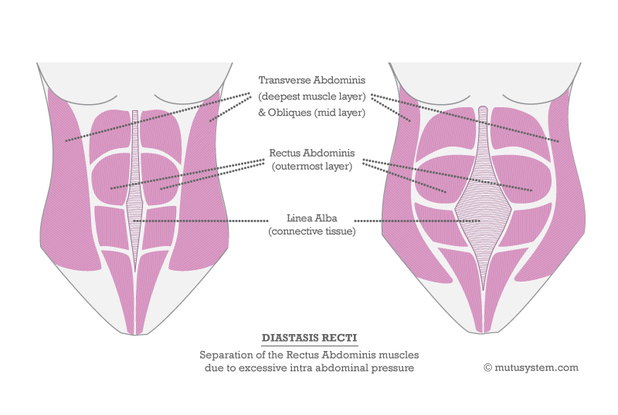Image from the excellent MuTuSystem.com
I remember lying on the bed after my first birth, feeling my slightly (oh, the benefits of being young) gooshy postpartum stomach. I’m super weird and have always kind of liked the postpartum softness there. I can think about what my body just did and anyway, I know it will go away. Or mostly go away. Postpartum gut is normal and expected since obviously your skin will not boing! back to how it was 9 months ago in a matter of days.
So I was feeling my stomach and found this great valley in my belly. Like a gaping cavern extending from my belly button in either direction. What fresh hell is this? says I.
That would be a diastasis recti. Or a splitting of the rectus abdominus muscles. It’s very common for the six pack muscles to pull away from each other in pregnancy as your body stretches for the baby. It’s less common for them to go back to how they were after the baby comes out. <insert sad face>
Worse, nobody talks about it!!! I had no idea. I had no idea what was up with my stomach muscles until I happened upon something during my second pregnancy. Doctors and midwives don’t check for it. So women of all ages go on an exercise overhaul to try to get a flat tummy and end up making it worse or losing weight but still having this inexplicable gut, plus back pain.
Why does it matter?
There’s nothing wrong with the natural changing of our bodies as we become mothers. What isn’t great for anyone is a weak core. If your ab muscles are split like this, your whole core is affected and weakened. This can mean back pain, fatigue, poor posture, risk of hernia, constipation, and less strength in daily functioning. Plus, with a split abdominal wall, all your guts can push out, giving you that 2-4 months pregnant look.
How do I know if I have a diastasis?
Lay down in crunch position and feel your stomach. When you begin a tiny crunch, do you feel a valley around your belly button? I’ve done probably 10 different diastasis tests and this is by far the best way to test for a diastasis.
If you are pregnant, you may have an outie belly button, or notice a little valley when you are wearing a tight shirt. Read more here.
What does it look like?
If it’s not too severe, in the morning you might look and think, “Wow, not bad, just a little gut now,” but by evening you think “How is this possible?” The growing belly by day, shrinking by night phenomenon, when small, is completely normal for humans in general. But if it’s a noticeable difference in bulge, and looks rounded like a pregnancy, it could be your guts pushing out between the split-diastasis recti.
Here are some pictures of women with diastasis (most fairly severe) and their pictures after an exercise program to fix it.
How bad is it? Can I fix it?
Yes! It will take daily posture and body mechanics changes and likely special exercises as well. It may take a year or more, and you may want to wear a splint. It all depends on how long, deep, and wide your separation is. You can find out how much work is ahead of you by using this video to test the degree of your separation. If it is very bad and has resulted in a hernia, only surgery can fix it.
How can I prevent diastasis or prevent it from worsening?
- Have good posture.
- Do squats, side planks, and conscious tightening of the transverse muscle in pregnancy.
- When pushing your baby out, use your transverse, not your rectus. You can learn all about this, but in general you want to squeeze your baby out rather than push her out. This is something that takes practice and presence of mind. Get used to the feeling of using the muscles in pregnancy. Pushing is bearing down and puts increased pressure on your gut. You want to squeeze or just breathe your baby down when you can.
- Do not jackknife to get up or out of bed. Always roll onto your side and use your hands to walk yourself upright.
- Have good posture-see preventing diastasis in pregnancy
- Do not do crunches, frontal planks, pilates 100, or many hands-and-knees position exercises.
- Only wear your baby on the front if you can maintain a tight core and good posture.
- No arching your back or intense swimming, anything where you flare your rib cage.
- Try not to strain on the toilet, cough excessively, or do anything that makes your belly push out.
- Push a stroller correctly- walk close to it, and keep your core engaged.
How can I fix it?
Find an exercise program (see below) designed for postpartum moms, or specifically for diastasis. Many trainers at the gym don’t even know what I’m talking about. Women go in and say, “I want to loose this gut,” and the trainers say “Great, do these crunches and planks, use this machine.” Without super core control and isolation of the correct muscles, most all of these traditional exercises will make a diastasis worse.
You can also use a splint. Wearing a splint after delivery can help with a host of things, including diastasis recti. You don’t want to splint forever–talk to a professional body worker or a physical therapist who specializes in pelvic/abdominal mama issues.
See a pelvic physical therapist–they can also evaluate your pelvic floor and build a program to help you prevent common pelvic floor problems–like peeing yourself, sex issues, and organ prolapse.
Here are some resources for healing a diastasis:
- Lorraine at pregnancyexercise.co.nz: great information, exercises, and programs
- Lindsay Brin, pregnancy and postpartum dvds and downloads
- Fit2BeMom, whole family exercise videos by subscription, all tummy safe
- MuTu System, a 12 week mom body program, very diastasis aware
- Tuppler Technique
- Find a personal diastasis therapist
 Image from the excellent MuTuSystem.com
Image from the excellent MuTuSystem.com


